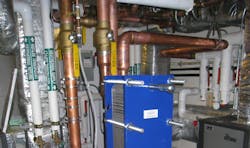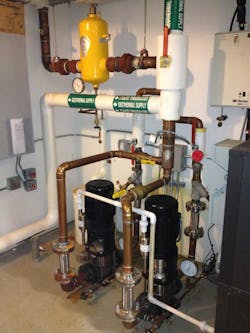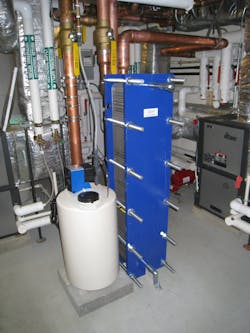Nelson Mechanical Design swoops in for geothermal system rescue
MARTHA'S VINEYARD, MASS. — Value engineering. It can be the bane of a contractor’s existence. If there is extensive value engineering during the construction phase, then often times the real-world implications of all those changes isn't known or considered until the project is over.
A 15,000-sq.-ft. home on the coast of Martha’s Vineyard — overlooking Vineyard Sound — was experiencing some major geothermal hiccups. After spending nearly $250,000 on the original installation of a geo system that didn’t work correctly, looking for answers and scratching his head in disbelief, the homeowner turned to Nelson Mechanical Design Inc. to re-engineer the system.
The large, 21-heat pump system — located in two mechanical rooms — experienced chronic heating and cooling issues: the heat pumps were regularly going off on fault codes; the home was cold in the winter and hot in the summer; and the system had small loop pumps inside and two geothermal supply wells with submersible pumps and three re-injection wells outside.
“This helped us realize that there was inadequate geothermal loop flow due in part to undersized loop pumps,” said Brian Nelson, owner, Nelson Mechanical Design Inc.
In addition, Nelson noted chronic air problems and found no air separators, and the controls were a tangled mess. The system would go through oscillations — the outside supply wells would pump well water to maintain inlet pressure but the valves that sent water back outside to the re-injection wells were opening based on loop temperature — the result was wild swings in loop pressure and temperature with the variable speed submersible pumps ramping up to full speed and then stopping, off and on.
Upon investigation, the fault codes helped Nelson uncover a workaround devised during the original installation to help the system limp along: the propane boiler was being used to artificially bring up loop temp to try to fool the heat pumps so they wouldn't go off on low flow/low temperature lock out.
“We discovered this ploy during the summer when we found out that the loop was hotter than we expected,” said Nelson. The boiler was “helping out” all year long so in the summer months the heat pumps would lock out on high temperatures, as well.
“This helped explain to the homeowner why his propane bill was so high and the savings he should realize from a geothermal system weren't there,” said Nelson. The team eventually changed the boiler control scheme so it was never used to heat the loop unless there the loop temperature dropped dangerously low. This made sure the boiler was not used to heat the loop at all unless both outside submersible pumps failed.
After further examination, Nelson found out that not only were the inside loop pumps undersized, but one of the loop pumps wasn’t even pumping at all because the impeller had fallen off the shaft. The reason was that the shaft had completely corroded, and even though the motor was ramping up and down from the variable frequency drive (VFD), no water was moving when that pump was on.
Nelson’s team also discovered that the entire inside of the geothermal system was coated with thick, red, sludge — iron bacteria from the outside wells. This coating of sludge had a major impact on the thermal efficiency of the entire system.
And to top it off, Nelson discovered that, in addition to all of the other design flaws, the well water itself had changed from 7 pH to 5 pH. “Approaching acidic water — and with all of the air in the well water — we had a recipe for disaster,” said Nelson.
The aquifer was changing due to the 80-gallon-a-minute peak load flow — as the Vineyard is a crazy quilt of different glacial deposits, different layers of the aquifer would get be exposed during high water use and would change the water chemistry.
The team found out that the original geothermal design was a closed system, which included 15 boreholes, primary/secondary pumping, and a glycol feed/purge station to eliminate air from the system.
During the ‘value engineering’ process, the boreholes were replaced with two supply wells and three re-injection wells. Only the secondary loop pumps were kept, and the air elimination equipment was deleted.
Therefore, the stage was set before construction began for a system with inadequate pump power for 21 heat pumps, constant introduction of well water with air and iron bacteria into the geothermal system, and no way to control the flow of well water into the geothermal system in a stable fashion.
Redesigned solution
The 21 heat pumps installed are ClimateMaster Tranquility series, with some of the heat pumps featuring the desuperheater option. Outside, two supply wells have submersible pumps with VFDs and there are three reinjection wells.
There are two mechanical rooms where the heat pumps are located with ductwork leading upstairs to the upper floors. The two main loop pumps can each handle the entire flow requirement and are both connected to VFDs. A Crestron iPad-based control system with remote sensors and some thermostats is used to control heating and cooling operation of the heat pumps.
The installation of a GEA plate and frame heat exchanger allowed for the separation of the well water from the inside geothermal loop, and would allow for the elimination all air from the loop. “This would allow us to stabilize the loop system pressure, and it would allow us to stabilize the loop temperature,” said Nelson.
The installation of the heat exchanger didn’t come without its challenges. The plate and frame heat exchanger size was limited by the width of the basement stairs. The team couldn't use a dolly on the stairs so the team — consisting of six men — had to carry each 400-pound end plate down the stairs.
“We mocked up different heat exchanger widths to make sure what we ordered we could get into the basement,” said Nelson. When the plate and frame heat exchanger arrived, Nelson’s crew disassembled it in the driveway, carried the 400-pound front and back plates (1" thick steel) down separately, along with the stainless steel heat exchange plates. Then they reassembled it in the basement mechanical room near the loop pumps.
Other mechanicals
Grundfos loop pumps were used for water circulation, and the system also included a Spirovent air separator sized for 100 gallons per minute. The DDC system (and the electromechanical emergency control system) is used to control the loop pumps based on differential pressure and the supply well pumps based on loop temperature.
“We measured all of the existing geothermal piping and carefully calculated the pressure drop to size new loop pumps,” said Nelson. “We went for redundancy so that the system would never be disabled due to loop pump failure.”
The DDC system was redone with a Johnson Controls control unit to reflect the new mechanical setup, and water treatment equipment for the removal of the iron bacteria in the geothermal piping and heat pumps in the building. Yaskawa variable speed drives — made in the United States — and Honeywell aquastats were also used in the redesign of the system.
“Once the heat exchanger and new loop pumps were installed, we flushed the entire system using the water treatment equipment we installed,” says Nelson. “We ran it for quite a while to finally loosen up the iron bacteria sludge in the system.”
Regaining control
Installing the mechanicals took approximately a week, but before that the diagnostic and service visits occurred for more than a year.
“It took us a while to see how bad this system really was,” said Nelson.
It took Nelson another month to present his findings to the homeowner and convince him to spend another $100,000 on his solution. After the installation, Nelson spent several months commissioning the controls — both DDC and electromechanical.
The existing control system was in total disarray and would need to be completely reprogrammed. As a result of Hurricane Irene, voltage spikes and drops cooked several control boards in the DDC.
The vulnerability of the control system to power issues from the grid/generator led the homeowner to ask for a bulletproof system. Nelson installed a complete electromechanical overlay so that during a big storm, the caretaker could turn a single switch from “Auto” to “Emergency.” This disabled the DDC system completely and ran the entire system using Honeywell aquastats and relays. The controls could now be safely isolated from any voltage issues and would last a lot longer.
What had turned out to be a homeowner’s mechanical nightmare, the house now is wonderfully comfortable, and all of the 21 zones are steady at their set points year-round. “Even in the coldest or hottest weather the house is comfortable with capacity to spare,” said Nelson.


